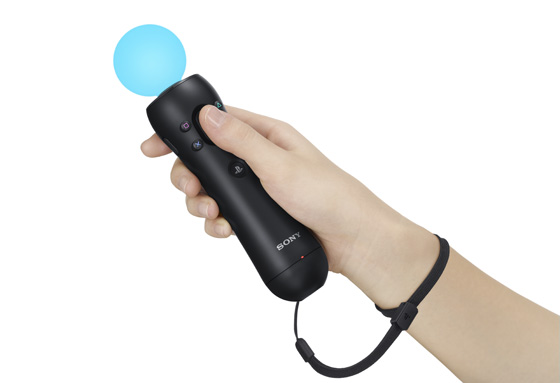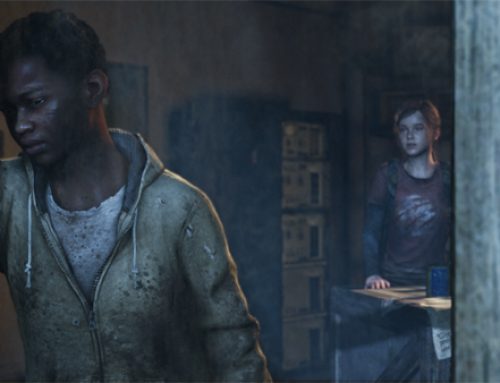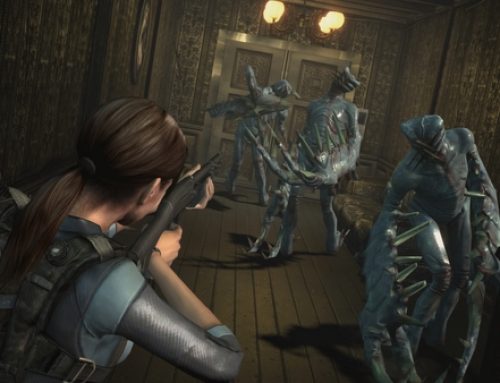
Writers for Kotaku have described the Move as looking like a "robot ice cream cone." Also, this is not my hand.
My column in Friday’s newspaper is a review of Sony’s new motion controller, the PlayStation Move, plus short writeups of four Move launch titles. I’ll be doing things a bit differently on the blog. In this post, I’m going to review the hardware only, in more depth than I do in the column.
I’ll follow over the next several days with longer pieces on each of the four launch games I’ve played. Some of what you’ll see in these posts will echo what I wrote for the paper, but in each case I plan to expand on what I wrote in print. A review of “Sports Champions” is here. On Friday, I’ll review “Start the Party!” with “EyePet” and “KungFu Riders” to follow either Friday or early next week.
It’s been nearly four years since the PlayStation 3 and Wii launched almost side-by-side, but Sony’s response to the motion-control craze Nintendo started is just getting to market.
Luckily for Sony, the PlayStation Move, the PS3’s new camera-based controller, is an impressive piece of technology. Nintendo has yet to even confirm it’s working on an high-definition version of its popular console, but it’s nearly impossible to think of a Move-equipped PS3 as anything but Wii HD.
The Move is really made up of two components, the PlayStation Eye camera ($40) and the Move controller ($50). You can buy them separately or in a bundle with the game “Sports Champions” that costs $100, a savings of $30 from buying them all individually. Another bundle includes all these things, plus a PS3 with a 320-gigabyte hard drive for $400 and a standard DualShock 3 controller.
I recently plunked down $100 for a couple of Move controllers to go with the PlayStation Eye I already owned and spent a couple of weeks trying out four Move launch titles provided by Sony for review.
If you haven’t seen it, the technology works a bit differently from what you’re used to seeing on the Wii. While the Wii uses an infrared sensor bar to track motion, Move uses the Eye video camera, which both opens up new gameplay possibilities and requires a bit more set-up on the part of the user.
Once you get the Eye and Move set up, though, the controls for the games in the Move’s launch lineup, with the exception of “KungFu Rider” are as responsive and accurate as anything you’ll find on the Wii. If you’ve had any experience with Wii games, controlling the action via the Move controller will quickly feel like second nature.
So the camera can see it better, the Move controller ($50) is topped by a light-up sphere that makes it look like what Kotaku’s writers have described as a “robot ice cream cone.” One of my biggest concerns with Move — and with Microsoft’s camera-based Kinect controller, due in November — is how it would function in my living room, which doesn’t have a ton of light. With just one underpowered overhead fixture and little natural light coming in, I worried the camera would struggle to pick up what I was doing.
My fears proved partially correct. In the games that project what’s going on in my living room on the TV, the picture was muddy yet viewable when I played at night. What surprised me, though, was that the Move controls were just as fluid and responsive as they had been during the day. I have to assume that’s because the Move is topped with a plastic ball that lights up. Because the camera is tracking the movement of the lighted ball, it presumably relies less on the information it gets about the positioning of your body or the controller. So those of you with dark living rooms can rest easy. The Move holds up fine.
The occasional muddiness of images shot by the camera, which isn’t exactly high-def anyway, really weren’t an issue. Even “EyePet,” which relies more on the camera than the other three titles I played, played great. The only area in which it was deficient was in the photo taking/uploading functions. So if you plan on taking family portraits with your virtual pet and sharing them online, you might want to invest in a couple of lamps to properly light your living room.
Aside from darkness, my other area of concern would be how the Move would perform in confined quarters. (I make it sound like I do all my gaming in a dark closet. In actuality, my living room is enormous, but it’s extremely long and narrow, meaning my TV is about 7 feet from my couch.
The cramped quarters didn’t appear to make much of a difference. I did need to move my coffee table a few feet closer to the TV, so I had room for footwork in “Sports Champions.” With “EyePet,” my wife and I didn’t have enough floor space for both the little critter and ourselves, so the coffee table got moved off to the side.
The need to clear a space with Move was an unexpected drawback to the new control scheme that I hadn’t foreseen initially. But it was easy enough to make space in our apartment that it wasn’t much of an issue. It could irritate players who tend to game in short bursts. Moving furniture around for 15 minutes of gameplay feels a bit silly when you could just buy a Wii and not have the same problem.
Sony has made the fact that the Move and its navigation controller (modeled after the Wii’s nunchuk, and available separately for $30) have more buttons into a selling point. And its true, having more buttons enables developers to create more complex games.
That said, the buttons were arranged on the Move controller to be simple and intuitive. Just like the A and B buttons on the Wii remote, the Move button and trigger (inexplicably called the T button) handle most gameplay functions. The other four buttons on the Move controller are arrayed around the Move button in an easy-to-remember configuration.
I actually found this placement to be preferable to what you find on the Wii remote. Though the Wii’s 1 and 2 buttons are designed to be used like the A and B buttons on the old NES controller when you hold the remote sideways, on motion-controlled games, the two buttons, as well as the + and – buttons, feel out-of-the-way and difficult to find. Not so with the Move.
Though its launch lineup is lacking in depth, the Move is a promising piece of technology. Everything seems to work just about as you expect it to, which means we probably won’t be getting an upgrade two years down the road like we did with Wii MotionPlus. It used to be quite common on the Wii, particularly with games that don’t use MotionPlus, to feel like you made a motion but the game got it wrong. The only glitch I ran into like this with Move happened one time when I moved too far out of the optimal position in front of the camera, and I short-armed a bocce ball throw in “Sports Champions.” It was easily corrected by taking a shuffle-step to the left.
If you’re at all curious about the Move and want a chance to check it out, GameStop stores around the country will be demoing the tech from 1-4 p.m. Saturday, with the games “Sports Champions” and “EyePet.” According to GameStop’s website, the nearest store to Sonoma County will be the one in Union Square in San Francisco. That’s kind of a haul, but if you happen to be in the city anyway this weekend, it might be worth checking out.



